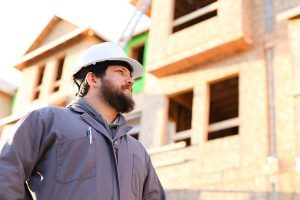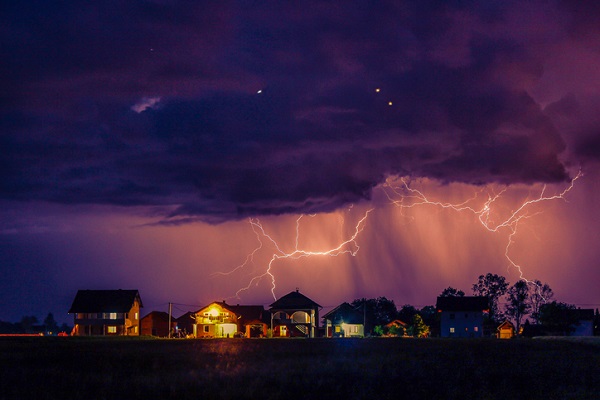Extreme weather is becoming more common. In fact, the United States suffered $92.9 billion in damages over 28 weather events in 2023 . These disasters damaged or outright destroyed many homes. As a builder, it’s becoming more urgent to build homes that can better withstand these weather and climate disasters. While building storm-resistant homes might cost a bit more, it’s an investment that pays big dividends.
Where to Start
Whether you’re building homes to withstand hurricanes, wind, fire, or hail, the best place to start is at the top. Fortifying the roof is one of the most important things builders can do to reduce damage caused by wind, hail, and fire.
This may mean investing in Class A fire-rated materials that interlock tightly, such as concrete, metal, or slate. While this could limit you in terms of aesthetics, it can do wonders in reducing the likelihood of total losses.
In addition, consider the strength of the garage doors you install. Garage doors can be a weak structural link during a storm. You may want to install a bracing system to provide extra stability. The braces can be stored in the garage and put up in less than three minutes if a tornado warning goes into effect.
Consider Using Fortified Home Program Standards
The Insurance Institute of Business and Home Safety (IBHS) has a set of construction standards designed specifically to help homeowners better protect their dwelling from high wind, hail, tornados, and severe thunderstorms.
The standards, known as the Fortified Home Program, are broken into three designation levels: bronze, silver, and gold. Those standards can also serve as an excellent guide for buildings to withstand, no matter the weather.
Here is a brief primer on a few other factors that can make the most difference in storm resistance.
You Build it, We'll back you up.
Learn why 1 in 5 new homes nationwide are covered by a 2-10 HBW Structural Warranty.
Hurricane Resistance
Hurricanes are becoming more common, more powerful, and more expensive. Since 1980, hurricanes have accounted for more than half of the total costs of extreme weather damage.
Here are a couple ways to fortify the homes you build in hurricane-prone areas.
Build high
Pointing to coastal regions such as the Florida panhandle, Building Science Corp. (BSC) says the obvious first step to keep a home from flooding during hurricanes is to build up “as high as possible and practical.” This means thinking deeply about how you’re designing the lowest levels of the building, and positioning important utilities and equipment higher up, too.
Use the right materials
Water-resistant materials make construction more likely to weather the storm. Concrete and masonry can provide a strong, water- and wind-resistant foundation, and can serve as pillars for elevated homes.
On the other hand, it’s a good idea to avoid water-sensitive materials when building in hurricane-prone areas. The challenge is that many builders commonly use two specific water-resistant materials in building: paper-faced gypsum board and foam plastic insulation for filling cavities.
Instead, you may consider using gypsum board with a fiberglass face over paper-face to reduce moisture problems. Likewise, you might consider insulating cavities on the exterior and designing your homes to let cavities ventilate moisture over stuffing them with foam.
You Build it, We'll back you up.
Learn why 1 in 5 new homes nationwide are covered by a 2-10 HBW Structural Warranty.
Wind and Fire Resistance
The forces of nature are sometimes unstoppable. But that doesn’t mean you can’t take steps to blunt their effects.
Think ICF
Instead of conventional wood framing, consider using insulated concrete forms (ICF). ICF features solid concrete walls with steel reinforcements.
Back to the roof
In addition to ICF construction, consider securing the roof to the walls with metal strapping (tie-downs or tornado straps) embedded into the concrete. This can provide significant wind protection.
Windows
Windows are also a critical piece of wind resistance. Read our article about mitigating window damage during high winds.
You Build it, We'll back you up.
Learn why 1 in 5 new homes nationwide are covered by a 2-10 HBW Structural Warranty.
Hail Resistance
Finally, hail resistance starts with a strong roof. Choosing the right roofing material can be a home’s best defense in a hail storm. Here are just a few ideas for protecting against hail.
- Asphalt shingles: Lightweight, low-cost, and easy to install. Use Class 3 and 4 impact resistance in hail-prone regions.
- Metal roofs: Long lasting and lightweight metal roofs with Class 4 impact resistance ratings can withstand hailstorm punctures.
- Slate: Also rated to Class 3 and 4 impact resistance, slate can outlast other roofing materials.
- Tile: Long-lasting and impact-resistant, tile can be porous, and material beneath it must be well-sealed to keep water out.

Go the Extra Mile With 2-10
While a New Home Warranty from 2-10 Home Buyers Warranty (2-10 ) won’t protect against damage from wind storms, tornados, and the like, it can help you protect against other, covered structural issues. And with complimentary marketing materials and guides, 2-10 can help you explain to your clients how to protect themselves against the extreme elements.
Join the 1 in 5 new homes in the US enrolled in the 2-10 New Home Warranty Program today.








